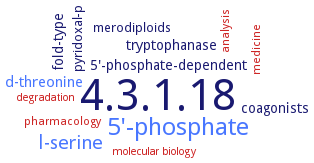4.3.1.18: D-Serine ammonia-lyase
This is an abbreviated version!
For detailed information about D-Serine ammonia-lyase, go to the full flat file.

Word Map on EC 4.3.1.18 
-
4.3.1.18
-
5'-phosphate
-
l-serine
-
d-threonine
-
tryptophanase
-
coagonists
-
fold-type
-
5'-phosphate-dependent
-
pyridoxal-p
-
merodiploids
-
medicine
-
pharmacology
-
analysis
-
molecular biology
-
degradation
- 4.3.1.18
- 5'-phosphate
- l-serine
- d-threonine
- tryptophanase
-
coagonists
-
fold-type
-
5'-phosphate-dependent
-
pyridoxal-p
-
merodiploids
- medicine
- pharmacology
- analysis
- molecular biology
- degradation
Reaction
Synonyms
chDSD, D-Hydroxy amino acid dehydratase, D-Ser dehydratase, D-serine ammonia lyase, D-serine ammonia-lyase, D-Serine deaminase, D-Serine dehydrase, D-serine dehydratase, D-Serine hydrolase (deaminating), DDB_G0289463, Dehydratase, D-serine, DSD, Dsd1p, DsdA, Dsdase, DsdSC, EC 4.2.1.14, PA3357, PH0054, Serine deaminase
ECTree
Advanced search results
Crystallization
Crystallization on EC 4.3.1.18 - D-Serine ammonia-lyase
Please wait a moment until all data is loaded. This message will disappear when all data is loaded.
crystal structure is refined to 1.55 A resolution. Crystal structure of DSD reveals a larger pyridoxal 5'-phosphate-binding domain and a smaller domain
crystallized by the hanging-drop vapour-diffusion method using PEG 4000 and 2-propanol as precipitants. The crystal belong to space group P422, with unit-cell parameters a = 105.0, c = 81.89 A, and diffract to 2.09 A resolution
to 1.9 A resolution. In the active site pocket, a zinc ion that coordinates His347 and Cys349 is located near the PLP-Lys45 Schiff base. A theoretical model of the enzyme-D-serine complex suggests that the hydroxyl group of D-serine directly coordinates the zinc ion, and that the epsilon-NH2 group of Lys45 is a short distance from the substrate C-atom. The alpha-proton abstraction from D-serine by Lys45 and the elimination of the hydroxyl group seem to occur with the assistance of the zinc ion, resulting in the strict reaction specificity
-
hanging-drop vapor-diffusion method, crystal structures of the native and 1-aminocyclopropane-1-carboxylate-complexed enzyme. The crystals of native and Se-Met belong to the space group P3(2)21 with unit cell parameters of a=b= 122.3 A, c = 115.0 A, and gamma = 120°, and there are three molecules in an asymmetric unit. The crystals of the ACC complex belong to space group P1 with unit cell parameters of a = 105.8 A, b = 147.2 A, c = 149.0 A, a = 73.18, b = 90.18, and gamma = 68.48, and 24 molecules are included in an asymmetric cell
homology model of Dsd. In this model, Dsd adopts a fold that is characteristic of type III pyridoxal-dependent enzymes, consisting of an alpha/beta TIM-barrel and a beta-sandwich domain at the N- and C-termini, respectively. Analysis of the Amide I and Amide III infrared bands reveals that the amounts of 24% alpha, 29% b and 47% unordered structures correlate well with those derived from the model, 25%, 29% and 46% respectively
-
both wild-type and selenomethionine labelled holoenzyme, to 2.4 and 1.9 A resolution, respectively. Significant electron density is not observed for the cofactor pyridoxal 5'-phosphate. Wild-type enzyme is in an open conformation while selenomethionine enzyme, crystallized in the presence of isoserine, is in a closed conformation suggesting that the enzyme is likely to undergo conformational changes upon binding of substrate. Thr166 may be involved in abstraction of proton from the Calpha atom of the substrate
-
hanging drop method at 25°C, 2.7 A resolution crystal structure of mutant enzyme T166A with bound pyridoxal 5'-phosphate


 results (
results ( results (
results ( top
top





